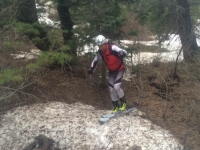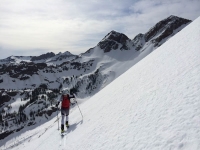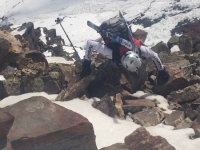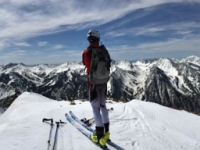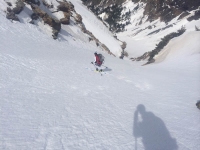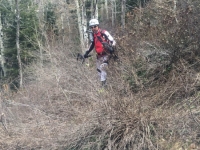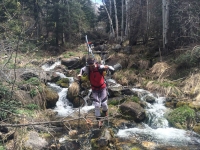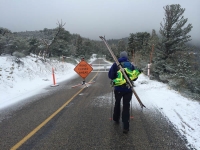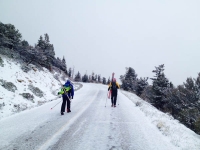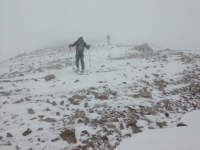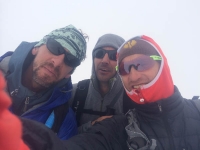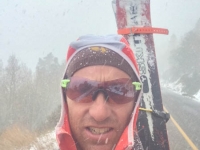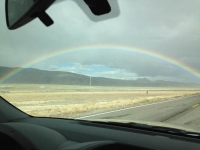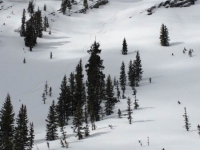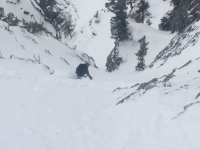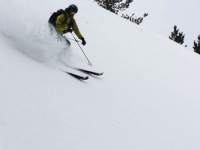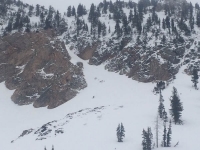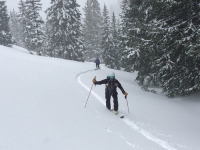I originally sat down to write about risk as a way of processing a year with far too many avalanche fatalities. I ended up with far more to say and write than I had planned, and I ended up with something that I felt should get more readership than just this blog. My friends over at Skimo.Co saw value in this and posted it to their site. Thanks to both Tom Diegel and Drew Hardesty for their feedback on this piece.
For many years, I have spent a lot of time thinking about risk in the mountains. What is risk? How can a person minimize risk? How do different people evaluate and perceive risk? Christian Beckwith’s Ninety-Pound Rucksack podcast is a fascinating account detailing the history of the 10th Mountain Division. However, each podcast ends with “….without risk, there is no adventure.” This has never quite sat right with me. Is it really true that adventure cannot exist without risk? How much risk is necessary for something to be an adventure?
People often describe others as having a high or low risk tolerance in reference to the risks they accept. In Luc Mehl’s recent Risk Ramble podcast, he argues there is no such thing as risk tolerance – only risk perception. For example, a Class V whitewater kayaker perceives the risk of paddling a Class V river as low, whereas a Class II paddler would perceive the risk of paddling that same river as high. Does the Class V paddler have a higher risk tolerance? Probably not; they just perceive the risk differently. To better understand risk perception, a person needs to understand what risk is.
Risk is always present – in the mountains, driving down the highway, in personal finances, and in most aspects of our lives. Let’s define risk before diving into how it relates to backcountry skiing. There are many complex definitions of risk based on various industries and activities. In the avalanche world, Grant Statham (Avalanche Hazard, Danger, and Risk – A Practical Explanation) defined risk as:

In this equation, “Hazard” is usually the easiest to define. Triggering an avalanche, terrain, weather, hitting a tree, and getting hurt are all simple examples of hazards.
Exposure is the main element you can control. It is where the hazard exists and how long we are subjected to it. Avalanche instructors teach that no matter the question, terrain is the answer. For example, if the hazard is a persistent weak layer (PWL) on the north-facing slopes, we can choose to ride south-facing slopes, thereby eliminating our exposure to the hazard and reducing our overall risk.
Vulnerability, on the other hand, is more difficult to define and control. It refers to how susceptible we are to the impact of a hazard. Returning to our example of a PWL on a north-facing slope, if we choose to ski a 35-degree north-facing slope, we have already accepted exposure. However, our level of vulnerability depends on our preparedness. Knowledge and skills are one of the best ways to reduce our vulnerability. To reduce vulnerability, we need to continually seek learning opportunities and then practice what we learn. Gear can also reduce vulnerability, but this doesn’t help until you are already impacted by the hazard. If we enter avalanche terrain without proper rescue gear— transceiver, probe, and shovel—we are highly vulnerable to the consequences of an avalanche. Conversely, if we wear a transceiver, carry rescue gear, and use an avalanche airbag, we cannot reduce our exposure, but we can reduce our vulnerability by increasing our ability to survive and respond effectively in the event of an avalanche.
While this might be “a practical explanation” it is still not simple. To measure the risk, one needs to think of all the hazards, the exposure (what is this again?), and the vulnerability (isn’t this very subjective to each person and also to what is going on in their lives separate from this specific risk.?). To simplify risk evaluation in the field, I often use the likelihood vs. consequence matrix:
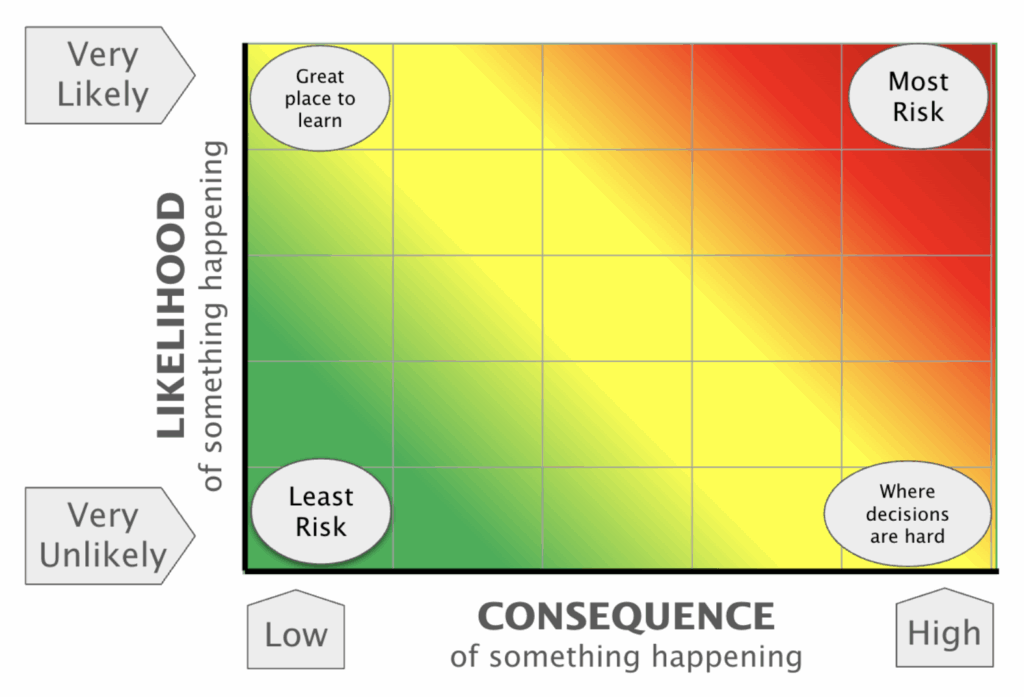
This matrix makes risk assessment more manageable. Regardless of the risk framework used, these concepts align with Luc Mehl’s idea of risk perception vs. risk tolerance.
While working at the Utah Avalanche Center (UAC), I remember UAC Forecaster Greg Gagne discussing risk. He had been talking to a non-backcountry skier friend and mentioned he was risk-averse. His friend immediately disagreed. “Greg, you spend lots of time in the mountains backcountry skiing, running, and climbing. Those are all risky activities. How can you say you are risk-averse?” At the time, Greg’s comments really resonated with me. Now, relating Luc’s recent podcast about risk tolerance vs. risk perception to this discussion several years ago really tied together the concepts of risk. Luc’s whitewater example mirrors Greg’s discussion about risk with his friend. Those of us who spend significant time in the mountains perceive risk differently than those who do not. This realization led me to question: Does our risk perception change over time? With experience? With education? With external influences? How can we ensure our perception of risk remains clear? As we gain experience, are we becoming blind to risk, or are we becoming risk-savvy – adept at identifying and mitigating it?
What does it mean to become risk-savvy? Being risk-savvy in the backcountry means more than just assessing hazards; it requires continuously refining our ability to recognize, evaluate, and mitigate risk. It means developing skills and acknowledging when conditions are beyond our skill set, when external factors like fatigue or group dynamics cloud our judgment, and when the reward simply isn’t worth the potential consequence. Risk-savvy travelers cultivate humility, understanding that experience alone does not grant immunity from accidents. They adopt a continuous learning mindset, adapting strategies based on conditions, new research, and past mistakes. They seek knowledge from their own experiences and those around them, embracing mentorship, collaboration, and honest self-assessment. Ultimately, being risk-savvy is about making decisions that allow us to keep adventuring—again and again.
What are some skills an adventurer needs to develop to become risk-savvy? These skills are far and wide and include things like
- Mountain skills such as terrain management, navigation, and weather
- Rescue skills, including avalanche rescue, first aid, and self-evacuation
- Interpersonal skills to prevent group dynamics challenges and to understand heuristic traps that can impact you and your group
During the 2024-2025 season, Utah has already seen five avalanche fatalities. This is almost twice our annual average of 2.7. Two of these fatalities involved solo travelers in avalanche terrain on “High” danger days. One was a solo traveler on a “Considerable” danger day. The other two were parties of two in avalanche terrain on days with “Considerable” danger. With these incidents, it is hard not to evaluate our own perception of risk.
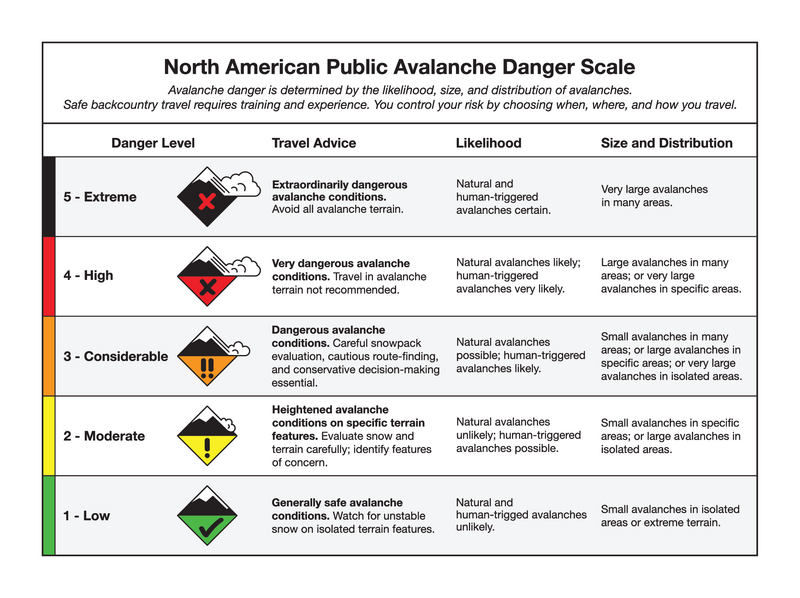
On “High” danger days, experienced backcountry travelers typically perceive the risk as high, while those without avalanche training often avoid the backcountry altogether. On those days, travel advice is to stay out of avalanche terrain (on or under slopes, >=30o). “Considerable” danger is more nuanced – it is a 3 out of 5 on the danger scale. That’s right in the middle – doesn’t that mean it is fairly safe? Isn’t that average danger (it is the median, after all)? Not quite. By definition, “Considerable” danger means human-triggered avalanches are “Likely”. The word “Likely” feels much stronger than a 3 out of 5. Imagine if we described car crashes the same way: “There is a 50% chance you will die in a car crash today” versus “It is likely you will die in a car crash today.” Neither sounds good, but 50% feels better than “Likely.”
In avalanche classes, I like to discuss the danger scale being exponential rather than linear. “Considerable” isn’t just a 3 but rather an 8. Recognizing this exponential increase helps put the increasing risk into perspective. “Considerable” isn’t just slightly more dangerous than “Moderate”—it’s significantly more dangerous.
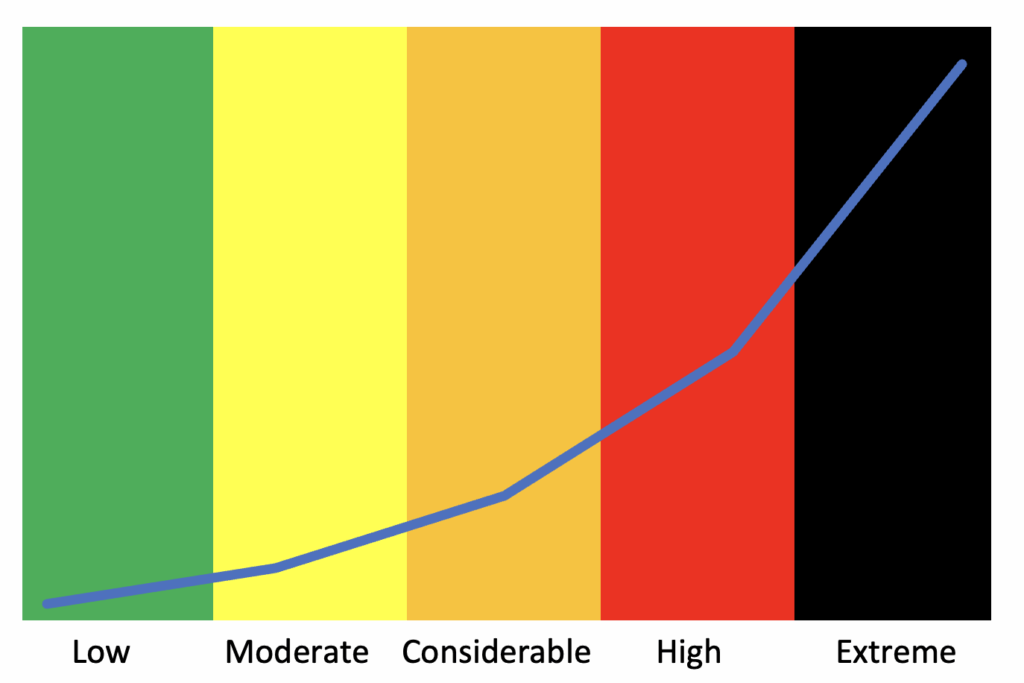
This season’s fatalities in Utah were experienced backcountry travelers. Based on their experience, they should have been risk-savvy. So what happened? What was their risk perception? Were they caught in a heuristic trap, believing their experience allowed them to beat the odds? Did familiarity with the terrain cloud their judgment?
Research indicates that the average age of avalanche victims is increasing (How old are the people who die in avalanches? A look into the ages of avalanche victims in the United States (1950–2018)), as is the level of avalanche education among victims (TAR 40.3, page 36). The backcountry is a “wicked learning environment“—one where feedback is often unclear or delayed.
Could this environment play a role in these avalanche fatalities? Does accumulating years of accident-free travel in the backcountry negatively impact risk perception, leading to the increasing age of avalanche accident victims?
We have ample time on the skin track which is a great time to prioritize positive group discussion from the avalanche forecast to concerns for the day. Luc proposes four simple prompts to help identify risk.
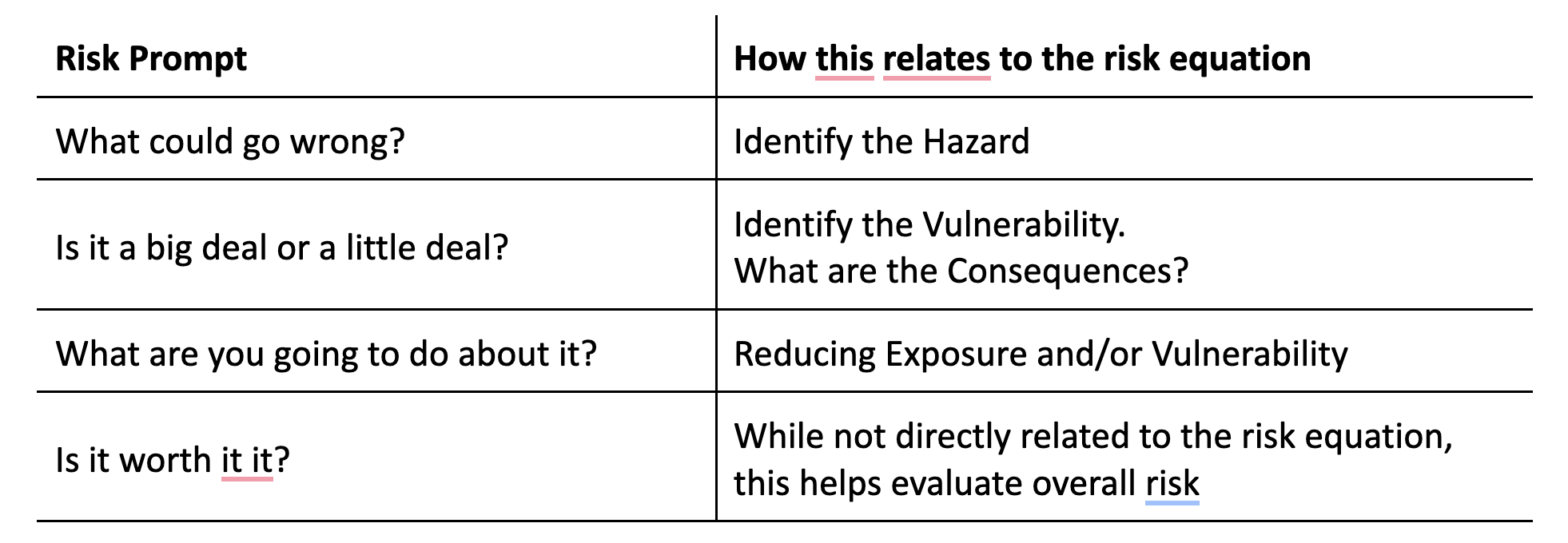
Returning to the likelihood vs. consequence framework: The avalanche forecast helps us assess the likelihood, but what about consequences? Several factors come into play. Some examples include:
- Terrain complexity: Are there terrain traps below you (trees, gullies, cliffs)?
- Rescue skills: How proficient are you in avalanche rescue, first aid, and survival techniques?
- Solo travel: Traveling alone increases consequences. Tom Diegel has written a thoughtful blog on solo travel—greater consequences mean risk should be adjusted accordingly.
- Remoteness: How far are you from rescue? How long would it take for help to arrive?
Besides avalanches, what other risks exist for your day out? Hitting a tree, tweaking a knee, breaking gear, getting lost – each carries its own likelihood and consequences.
Suddenly, risk assessment becomes quite complex. You must decide which levers to pull—reduce likelihood by avoiding avalanche terrain or specific problem areas, or reduce consequences by improving skills and preparation. Either way, moving further from the high likelihood/high consequence red zone is key.
With so many variables, it’s easy to misjudge risk. So perhaps it is true that “there is no adventure without risk.” However, becoming risk savvy and understanding and managing that risk is what allows us to keep adventuring.































